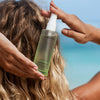Today is World Reef Day, a reminder of just how important it is to conserve the integrity and diversity of our reefs and the marine life that lives in them.
It’s also a striking call to action for all of us in the beauty industry. We need to ensure that our principles, our practices and our products take into account, and are held accountable for, the protection of reefs.
Why are reefs important?
When you think of coral reefs, images of colourful ecosystems that are bursting with marine life and worthy of Pixar’s Finding Nemo tend to spring to mind.
For the most part, this picturesque, Finding Nemo vision isn’t far from the truth. Although coral reefs only cover less than two per cent of the world’s oceans, they provide a home for a quarter of all marine life, making them busy aquatic cities for coral, fish, marine mammals and crustaceans alike.
From underground networks of sea sponges to the lofty heights of sea anemone skyscrapers and reef inhabitants scuttling and gliding on their commute from A to B, there’s a subtle resemblance to the living and breathing cities we share on land.
However, in contrast to our concrete cities, which seem to be growing at rapid rates and sprawling at will, our underwater cities, our coral reefs, are showing worrying rates of decline.
As well as providing essential habitat for marine life, many of which are also endangered, coral reefs are also a key defence against coastal erosion, offering protection from storms for coastal communities.
So, just as rainforests are often described as the lungs of the earth, coral reefs deserve equal status as the heart of the ocean. A living, beating environment that needs to be protected.

How does our sun care impact reefs?
The detrimental impact of rising water temperatures, pollution and single-use plastic on our oceans and coral reefs is one that’s been heavily publicised.
As someone who cares about the fate of our reefs and other marine life, you wouldn’t leave your plastic sun lotion bottle at the beach would you? However, the ingredients inside that bottle can have an equally negative impact on our reefs.
Ingredients such as oxybenzone, octocrylene and octinoxate can cause significant harm to our ecosystems and contribute to marine pollution.
According to the US National Oceanic and Atmospheric Administration, unsafe sunscreen chemicals can accumulate in coral tissues, leading to bleaching and DNA damage.
It’s for this reason that Palau and the US state of Hawaii signed legislation to ban sunscreens that contain oxybenzone, in an effort to protect their coral reefs.
Reef-safe sun care

When it comes to sun care, we take that second word very seriously. Not only should your sunscreen protect your skin from harmful UV rays, but it should be environmentally safe too.
That’s why we’re proud that our sunscreen range is the first in Europe to be certified by Protect Land + Sea, meaning all of our sunscreen products are safe to use in oceans and coral reef environments.
We were awarded this certification by Haereticus Environmental Laboratory, who have independently tested our entire sunscreen range to certify that none of our products contain ingredients that are known environmental pollutants.
The future of our reefs

We care about your skin and want our coral reefs to be around for generations to come, which is why we’ve created a sunscreen range that does both.
Small choices such as checking the ingredients label on our sunscreen can have a collective, larger impact.
Most of us are familiar with the narrative for Finding Nemo – a father who wants to bring his son back to the reef they call home. However, that story would be very different if that home no longer existed, and so too would our world.

 Skincare
Skincare
 Gifts
Gifts

 Bestsellers
Bestsellers
 Makeup
Makeup
 Body Care
Body Care
 Men's
Men's
 Hair Care
Hair Care
 Mama & Baby
Mama & Baby
